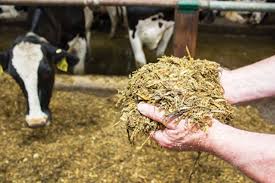How to Make Silage for your Animals

Silage is the fodder which is conserved by reducing pH through natural anaerobic fermentation and is used for feeding during scarcity period, drought or floods and for Utilizing surplus forage. The suitable crops are sorghum, maize and oat etc. During lean period feeding of silage acts as a green fodder and maintains livestock productivity.
Silage making means preservation of chaffed cereal green fodder in anaerobic condition by way of fermentation method. In anaerobic condition (no air inside pit/tank),with the help of micro organisms, sugar contained in green fodder is converted in to Lactic acid ,which help to preserve the green fodder for longer duration.
Respiratory function of living cells present in green chaffed fodder utilises Oxygen in air tight condition & releases water & carbon dioxide in closed environment in pit/tank. Due to Carbon dioxide releases in pit/tank, air inside is expelled outside as well as organism which depends on oxygen (Like bacteria & Fungi) cannot withstand in CO2 atmosphere in Tank/Pit. These effects in to preservation of chaffed green fodder in silo pit/tank as silage for longer duration (6 months or max. a year if good care is taken)
How Silage is prepared?
During the silage making process, the pasture is cut when the grasses contain the highest nutrient levels. This level is attained just before they are fully mature.
The reason why it is cut just before they are fully mature is that all forms of preserved grass, such as hay and silage, will have lower amounts of nutrients than fresh pasture, so everything must be done to make the end product be as nutritious as possible.
During Silage preparation, the grass is allowed to wilt in the field for a few hours to reduce the moisture content to around 60-75% as this is the optimum level. If the grass is left out longer, it may get too dry, or it may get rained on – and both these will reduce the efficiency of the fermentation.
Process in silage making
1. Selection of forage crops and their maturity stage
The optimum dry matter for crop harvesting for silage depends on the stage of harvesting (Table 1). Most of crops are harvested at 50% flowering to dough stage when the moisture content varies between 18-22%. After overnight wilting the dry matter content become 30-35% which is proper dry matter content for ensiling. Table 1: Optimum stage for crop harvesting Common forage crops Stage of harvest Maize 50% flowering to dough stage Sorghum 50% flowering to dough stage Bajra 50% flowering to dough stage Oat Boot to dough stage
2. Steps in silage making
Silage making involves four major steps viz., harvesting and transportation, chaffing, filling and compaction and covering of silo.
1. Pit making:
Firstly, a silage pit has to be dug for storing silage. The pit size may be determined based on the amount of silage to be stored. A pit with a dimension of 1 metre wide X 1 metre length X 1 metre depth can store 500 kilograms of silage. The location of pit should be free from water stagnation. The pit should be surrounded on all sides with thick plastic sheet. Pit can also be constructed using bricks and cement.
2. Preparation of fermentation mixture:
For preparing 1 ton silage, the following materials are required.
Molasses – 1 Kg
Salt – 1 Kg
Mineral Mixture – 1 Kg
DCP (Di-Calcium Phosphate) – 1 Kg
LAB (Lactic Acid Bacteria)
Urea – 1 Kg
Mix all of the above into a drum by adding water
 Learn More
Learn More3. Harvesting and transportation of crop (ensiling):
Harvesting at proper stage but delay in transportation may lead to loss of excess moisture results in haylage (DM 70-80%)
4. Chaffing:
It has to be chaffed into small pieces preferably 2-4 cm length using a chaff cutter. This improves the packing density which favours the growth of lactic acid bacteria, naturally present in crops. Add the fermentation mixture in small quantities as the fodder is loaded to chaff cutter. Position the chaff cutter so the chaffed fodder directly falls into the silage pit. Level the chaffed pieces evenly and press it hard so that all air comes out. Pressing and removing air is very important.
5. Filling of silo and compaction:
Chaffed material should be spread evenly over entire surface of silo (the structure) and then compacted through trampling (in case of small silo). In case of large silo (trenches) the compaction can be done using tractor. It helps in rapid evacuation of air from the silo, thus checks the aerobic respiration and nutrient loss.
6. Properly sealing and covering of silo pit:
It should be done in such a way that neither air enters in to the silo nor the gas comes out from the silo. It is better to use polythene sheet but care should be taken that entire surface of polythene sheet should be covered with straw or any other dried material up to 6-8 inch thickness to avoid the damage of polythene sheet by dog, cat or other animals. Make sure water does not enter the pit during rains. The silage will be ready in 45 to 60 days, depending on the types of material used. The silage of thin stem crop like oat becomes ready in 45 days while thick stem crops like maize, sorghum and bajra become ready in 60 days. Ideal silage is golden yellowish green colour with good aroma. After completion of incubation period the silo is opened for feeding. The whole silo should not be disturbed and it should be opened from one place/corner to avoid the loss of moisture and nutrients. Depending on the type of animal, stage of production and availability of silage it can be supplemented in the ration (5-25 kg per animal) of animal during lean period. After opening the pit, silage should be used within 30 days.










